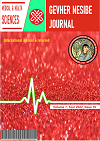Characteristics and Management of Unplanned Hospitalizations from the Emergency Department to our Surgical Oncology Clinic: A Single Center Experience
DOI:
https://doi.org/10.46648/gnj.271Keywords:
Unplanned hospitalization, readmission, emergency department, postoperative complication, surgical oncology clinicAbstract
AIM Unplanned and emergency hospitalizations in oncology clinics bring additional costs to health services provided and additional burdens on service planning of the hospitals. We have very little information because studies on this subject are insufficient. This study, it is aimed to discuss unplanned and urgent admissions from the emergency department to a surgical oncology clinic in the light of current literature. PATIENTS AND METHOD Medical records of 227 consecutive patients admitted to our clinic were collected and reviewed retrospectively over electronic data system. The patients' data were analyzed according to their demographic and clinical characteristics and classified according to the pre-diagnosis, gender, reasons for hospitalization, initial treatment, clinical referral to the emergency room, and the type of treatment administered after admission. Categorical variables were evaluated with Pearson Chi-square or Fisher's exact test. For p<0.05, the results were considered statistically significant. RESULTS Mean age of the patients was approximately 60 years, and gender distribution was equal. The most common admission to the emergency department was the patient's admission (67.4%), the most common primary diagnosis was gastric cancer (31.3%), and the most common emergency pathology requiring hospitalization was ileus-subileus (50.7%). 25.5% of admissions consisted of patients who were readmitted after discharge. After hospitalization, 38.3% of the patients required a significant intervention. Most patients were admitted during working hours (85%) and on weekdays (89%). The mean Charlson comorbidity index was 6.8 for those who had major surgery and differed significantly with the probability of undergoing major surgery (p= .012). CONCLUSION Most of patients had pathology requiring intervention. These patients required palliative care. However, acceptance rates of patients for palliative care, which should be considered, necessitate revision of these services. In addition, high number of early readmissions requires us to review our criteria for post-operative care, management of complications, and discharge.
Downloads
Published
How to Cite
Issue
Section
License

This work is licensed under a Creative Commons Attribution-NonCommercial 4.0 International License.


